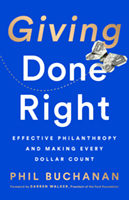This post is the sixth in a series of seven excerpting CEP President Phil Buchanan’s new essay, Big Issues, Many Questions, which explores five pressing issues facing U.S. foundation leaders and boards at this moment in time.
After a period in which grantees were often seen by funders as akin to contractors or vendors, paid to produce “outcomes,” there is a growing recognition that nonprofit organizations need to be supported — and strengthened — and relationships attended to if foundations are to achieve their goals. I am hearing less often from foundations the idea that “grantees are just a means to an end” and that “if grantees don’t like working with us, then we must be doing something right.” (I am not making this up.)
Maybe, finally, as The Whitman Institute’s John Esterle and his colleagues put it, relationships are moving from the “kids’ table” to the “adults’ table” in the conversation about impact. We see in our work at CEP more interest in what we have learned about the program officer-grantee relationship, manifested by foundations wanting to see breakdowns of Grantee Perception Report® (GPR) ratings according to program officer, as well interest in our research and workshops focused on this topic.
We also see more interest in supporting organizations. While the overwhelming proportion of grant dollars are still program restricted, there is movement here. The Blue Meridian Partners’ effort responds to a perception of a desperate lack of funding needed to grow organizations with programs that have been proven to have impact. Similarly, the efforts of the Ford Foundation, Citi Foundation, Chicago Community Trust, and others to provide more six-figure and greater multi-year unrestricted general operating support to grantees — the kind of support our research has shown is correlated with higher perceived impact — are hopeful signs of a newfound appreciation of what nonprofits need to be effective.
While foundations such as the William and Flora Hewlett Foundation have promoted this kind of support for a decade or more, there seems to be real momentum now. These initiatives may finally push the proportion of general operating support well beyond its relatively flat recent rate of about 20 or 25 percent of foundation grant dollars.
The focus on building stronger organizations need not be just about “scale” of individual organizations or “replication” of programs. Many nonprofits are local and small, and this isn’t always bad. We can encourage more sharing of what works across organizations — “scaling impact,” in the words of Jeff Bradach of The Bridgespan Group. Bradach has written about the potential of “aligned-action networks” as an alternative to the tight control of either “program replication” or so-called collective impact.
What we are seeing now is an increasingly sophisticated discussion that is redefining scale. The emphasis is on continual learning and improvement and spreading what works, while allowing for variation to accommodate differing geographies and contexts. Foundations can do more to support this kind of sharing among nonprofits, as well as a variety of forms of collaboration to increase efficiency and effectiveness. Philadelphia’s Nonprofit Repositioning Fund, led by CEP board member Nadya Shmavonian, is an interesting new pilot effort by a group of funders “to encourage and support mergers and other types of formal, long-term collaborations between nonprofit organizations.”
Supporting organizations and not just programs means supporting their administrative expenses — and not dismissing anything related to investment in strengthening an organization as “waste” or “overhead.” Although nonprofit and foundation leaders have been railing for decades against the overreliance on administrative spending ratios as a terrible proxy measure for effectiveness (I’ve been one of them), there is increasing momentum on the topic.
One way to make progress is through the provision of more general operating support. Another way is to offer more flexible program support. Foundations such as Hewlett and Ford are doing both, offering general support but also, when that doesn’t make sense, providing what Hewlett calls “general support to program.” If grants must be tightly restricted, then funders can at least allow for more support of overhead. Tim Delaney of the National Council of Nonprofits has been among the leaders on this topic, successfully arguing for a change in the rules for federal grants to support more overhead. Major foundations have reexamined and changed their rules on overhead, too, allowing higher proportions.
Spending on “overhead” isn’t irrelevant. We should all be concerned about nonprofits utilizing for-profit fundraisers that keep 50 or 75 cents on the dollar without donors knowing it, for example, but it has been overly relied upon as a metric. Jacob Harold of GuideStar, H. Art Taylor of BBB Wise Giving Alliance, and Ken Berger (formerly) of Charity Navigator deserve credit for arguing that we need to reject “the Overhead Myth”.
For all the talk about how best to support grantees, nonprofits also need a greater voice, as CEP, GEO, NCRP, and many others have argued. The majority of the largest 50 foundations in the country and hundreds of other foundations utilize CEP’s GPR — a tool that didn’t even exist 14 years ago — to learn how grantees see them across a range of dimensions. CEP’s research also has helped amplify the grantee voice; for example, through our Grantee Voice Panel, which we have regularly surveyed on key issues. As foundations seek to do a better job supporting those on whom they rely to achieve their shared goals, I believe — and we have evidence to support this — that these efforts have informed discussion and change. Foundations today are listening to nonprofits in a way they haven’t always.
Foundations seek to achieve their programmatic goals by many means. Grants to nonprofits are just one of them — but a central one for most.
Foundations need to ask themselves:
- Which are the organizations we see as vital to our strategies—and how are we supporting them to become stronger, more sustainable organizations to do that work well into the future?
- Is the foundation sufficiently staffed and resourced to do the work of supporting nonprofits well?
- Does the foundation create incentives for underinvestment in organizational capacity through an overemphasis on keeping “overhead” (however it is defined) low?
- What proportion of the foundation’s grants are large, unrestricted, and multiyear—and what would it take to increase that number?
- How can nonprofits be better supported in a way that is consistent with a foundation being outcome-oriented and strategic in its approach?
- How are we creating a culture and performance appraisal systems that reward program staff for building strong relationships with grantees?
- How can the foundation support organizations to learn from each other and work with each other toward the achievement of shared goals?
On Thursday, I’ll discuss a couple of issues I didn’t include among the five I have written about and ask, what have I missed?
Download Big Issues, Many Questions here.
Phil Buchanan is president of CEP. He can be reached at philb@cep.org. Follow him on Twitter at @PhilCEP.










